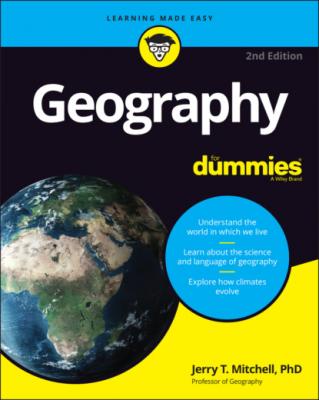ТОП просматриваемых книг сайта:
Geography For Dummies. Jerry T. Mitchell
Читать онлайн.Название Geography For Dummies
Год выпуска 0
isbn 9781119867142
Автор произведения Jerry T. Mitchell
Жанр География
Издательство John Wiley & Sons Limited
Regions make it easier to comprehend our Earthly home. After all, Earth consists of gazillions of locations, each of which has its own particular and peculiar characteristics. Knowing every last one of them would be impossible. But we can simplify the challenge by grouping together contiguous locations that have one or more things in common — Gobi Desert, Islamic realm, tropical rainforest, Chinatown, the Great Lakes, suburbia — each of these is a region. Some are big and some are small. Some refer to physical characteristics. Some refer to human characteristics. Some do both. But each facilitates the task of understanding the world.
Features that characterize different locations on Earth and, therefore, epitomize the concept of place, will be the focus of several chapters. These include landforms (Chapters 6 and 7), climates (Chapter 10), population (Chapter 11), culture (Chapter 13), economic activity (Chapter 15), and urbanization (Chapter 17). Each of these characteristics, of course, pertains not only to particular locations, but also to large areas as well. Thus, they also serve to characterize and define regions.
Why things are the way they are: Physical systems
I bet you have a favorite time of year, a favorite season. You probably also have a least-favorite season. No doubt you can tell me why you like some seasons more than others, and you can probably sprinkle your rationale with personal anecdotes about good times and bad. If that sounds about right, then you are already familiar with physical systems.
Atmosphere, land, and water are the principal components of the physical world. Geography seeks to understand how these phenomena vary from one location to the next and why. Geographers aren’t content to know what the world looks like. They also want to know how it works. Why do islands like Aruba (near South America) and Socotra (off the Arabian peninsula), thousands of miles apart, have similar climates but differing land features? That involves understanding the natural processes that shape and modify Earth’s surface (see Chapters 6 and 7), cause particular climates to occur in particular places (see Chapters 9 and 10), or result in some parts of Earth having too little water and others too much (see Chapter 8).
Giving that human touch: Human systems
Have you ever visited a locale that has many more or many fewer people than where you live? Have you ever moved a long distance? Have you ever visited a foreign country? Have you ever noticed that most of your shoes and clothing are made in a foreign country? Have you ever attempted to talk to someone, only to discover that person does not speak your language? Have you ever tried a very different cuisine (such as polishing off a mopane worm in South Africa as I have done)? If so, then you are already familiar with human systems.
Human beings characterize Earth’s surface. That is, not only do humans live here, but by constructing cities, making farms, laying railways, and building other things, humans are an actual part of Earth’s surface. Culture, trade, commerce, and government largely determine the specific ways in which people are part of Earth. And because these institutions are so diverse, so, too, are the human characteristics that are part of Earth’s surface. Key aspects of human geography will be dealt with in separate chapters. They include population characteristics (see Chapter 11), movement and migration (see Chapter 12), cultural attributes (see Chapter 13), division of Earth into political units (see Chapter 14), economic activity (see Chapter 15), and urbanization (see Chapter 17).
Interacting with the world around us: Environment and society
Do you remember a farm or piece of countryside that is now a shopping center or a housing development? Have you ever experienced air pollution or water pollution? Have you ever had to cope with a severe storm, flood, or earthquake? If so, then you are already familiar with environment and society.
Human beings and the natural environment interact in many ways. For example, people play a very important role in shaping and modifying the natural world. Some results of this interaction may be visually pleasing, such as the skyline of Paris, or the terraced rice paddies of Southeast Asia, or the English countryside. But other results may be troubling, such as pollution and global deforestation, or the landscape devastation and human health problems stemming from Chinese uranium mining in Africa. References to human impact on the environment will appear in several chapters, particularly the ones dealing with water (see Chapter 8), natural resources (see Chapter 16), and urbanization (see Chapter 17). Most importantly, an entire chapter will be devoted to matters of environmental quality (see Chapter 18).
And while people impact the environment, environmental phenomena impact people. Climate affects agriculture and other human activity (see Chapters 9 and 10). Landforms and related processes and hazards affect life and property — think how Hurricane Katrina in 2005 upended the entire Mississippi coastline (see Chapters 6 and 7). The geography of water impacts settlement and commerce (see Chapter 8). In a nutshell, relationships between environment and society are pervasive, profound, and often political — and for those reasons will manifest themselves in several chapters.
Putting geography to use: Uses of geography
Have you ever used a mapping website to plan a trip? Have you ever visited a historical site and looked at maps and exhibits that help you understand the past? Have you ever attended a meeting or read an article concerning a proposal that would change the physical character of your neighborhood? If so, then you are already familiar with the uses of geography.
You can use geography to understand the past, interpret the present, or plan for the future.

